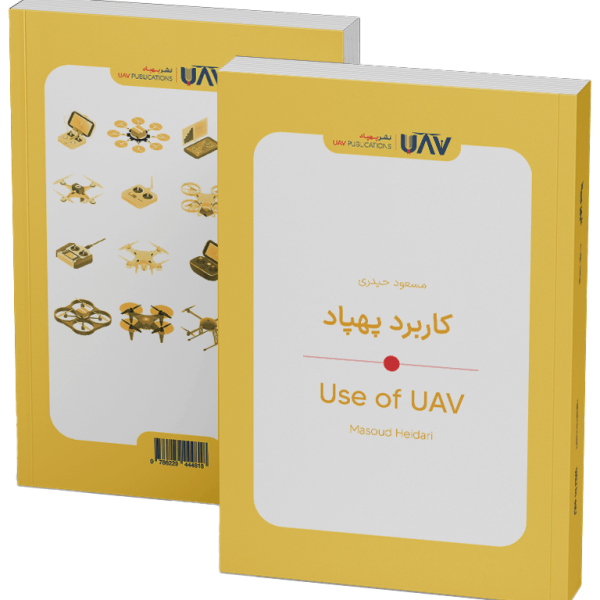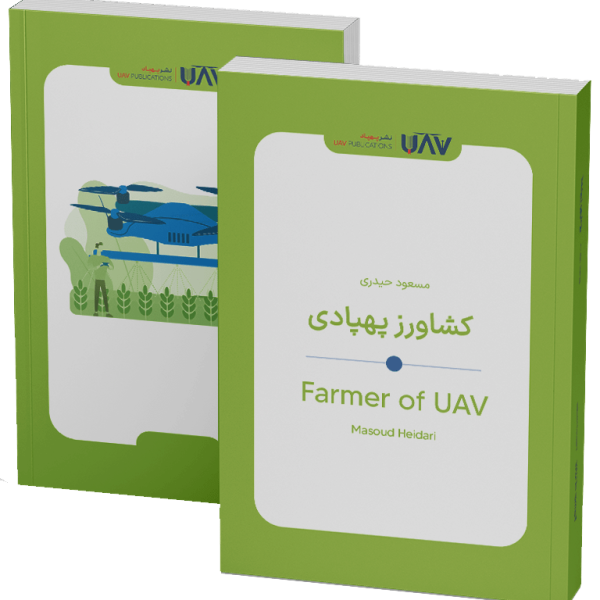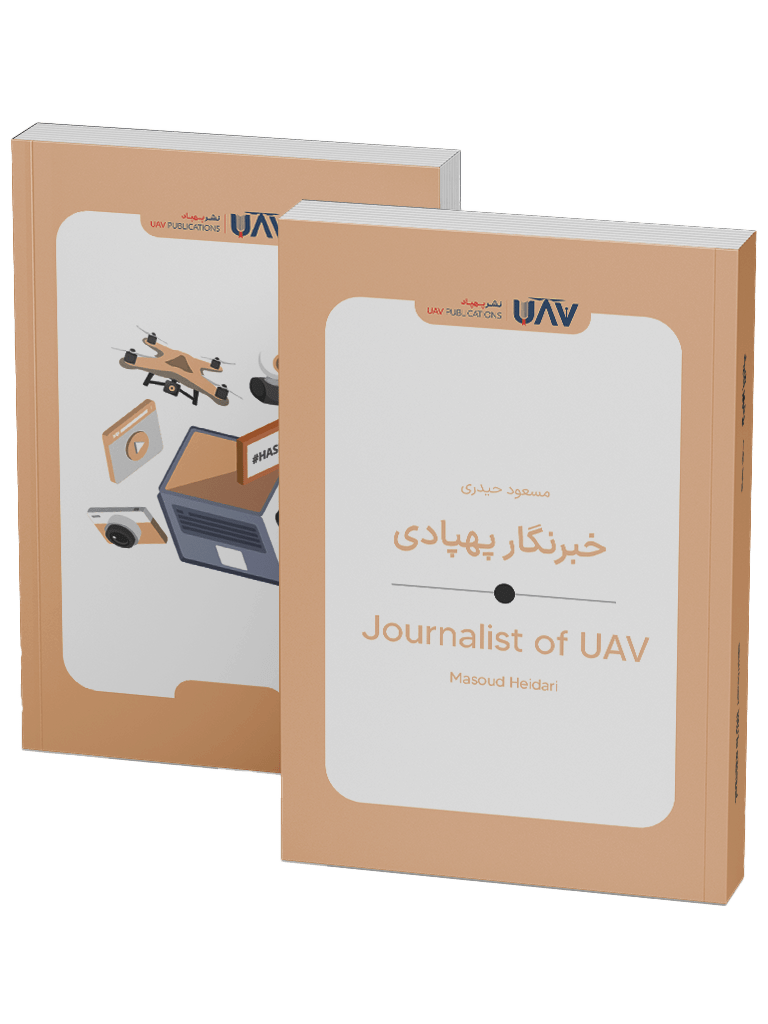Book – Journalist of UAV
Journalist of UAV, written by Masoud Heidari, is the first specialized Persian-language book dedicated to the use of unmanned aerial vehicles (UAVs) in journalism. This work offers an analytical, practical, and realistic perspective, introducing readers to the opportunities, challenges, and emerging horizons of UAV-assisted reporting. From crisis coverage and investigative journalism to ethical concerns and global storytelling, the book explores a wide range of critical topics. It is an essential resource for journalists, media students, social activists, and anyone interested in the intersection of media and technology.
Introduction to the Book: Journalist of UAV
In an era when emerging technologies are reshaping traditional media boundaries, Journalist of UAV by Masoud Heidari stands as one of the first Persian-language sources to provide a profound and comprehensive examination of the intersection of journalism and UAV technology. With both practical and analytical insight, this book introduces readers to the opportunities, challenges, and prospects of journalism carried out with drones—a rapidly evolving field that is increasingly finding its place in modern media.
This work not only examines global experiences but also offers a realistic depiction of Iran’s current landscape in the realm of Journalist of UAV. Whether you’re a journalism student, a field reporter, or simply someone interested in cutting-edge media technologies, this book provides a professional gateway into this emerging field.
How Do Drones Serve the Media?
Just a few years ago, most news footage came from ground-level perspectives—either captured by on-site journalists or, at best, from expensive helicopter setups. The advent of drones has revolutionized this dynamic, enabling a new form of aerial reporting. Drones can quickly reach disaster sites without endangering human lives. They access remote, hazardous, or even restricted areas and deliver precise, sometimes live, visuals that provide unprecedented insights to newsrooms.
Beyond offering broader vantage points, drones empower the media to report more accurately, thoroughly, and rapidly. In today’s fiercely competitive media environment, owning a drone is like possessing a bird’s-eye lens to tell the story more truthfully and compellingly.
What Is Journalist of UAV?
Journalist of UAV is a newly emerging branch of reporting where journalists or media teams employ UAVs (unmanned aerial vehicles) to gather data, conduct aerial photography, assess environments, and even engage in crisis response. This discipline is founded on the convergence of media knowledge, technical proficiency, and a firm grasp of professional ethics.
In this context, a drone is far more than a flying gadget—it is a professional journalistic tool that must be used deliberately, responsibly, and in compliance with legal boundaries. Journalist of UAV goes beyond capturing images from above; it encompasses narrative design, strategic framing, content editing, and visual analysis.
This field has become particularly vital in investigative journalism, crisis reporting, environmental coverage, and urban development.
A Brief History of “Flying Journalists”
Though still a relatively new phenomenon in media history, Journalist of UAV dates back to the early 2010s. The University of Nebraska and leading outlets, such as the BBC and The New York Times, were among the first to incorporate drones into newsgathering, initially for covering natural disasters, public protests, and environmental crises. As access to drone technology became more widespread, local and independent media joined the trend.
Academic institutions began offering courses under the label “Journalist of UAV,” and ethical frameworks were established to guide the practice. Governments also moved to regulate this domain. This swift but rich history shows that Journalist of UAV is no longer a luxury—it is becoming a core component of contemporary reporting.
Global Experiences in Journalist of UAV
Countries have taken varied paths in developing Journalist of UAV. In the United States, the University of Nebraska pioneered formal educational frameworks for drone reporting in collaboration with journalism colleges. The New York Times used drones to redefine visual storytelling through documentary-style footage.
Across Europe—in Germany, France, and the UK—both freelance reporters and major media networks used drones to cover protests, assess crisis zones, and document climate change. Even in developing nations, drones have offered access to remote or censored regions. Journalist of UAV illustrates how global case studies can inspire national and local media to adopt this transformative tool.
What Skills Does a Drone Journalist Need?
Journalist of UAV is an interdisciplinary field that blends media expertise with technological fluency. A journalist entering this realm needs more than just interviewing and writing skills. They must also understand drone flight principles, aerial regulations, flight safety, aerial photography, and visual content analysis.
Essential skills include:
- Familiarity with national aviation laws.
- Proficiency in drone control software.
- Understanding of aerial imagery composition.
- Content editing capabilities.
- (In advanced roles) Knowledge of geospatial data collection and 3D mapping.
This book emphasizes that a drone journalist is not merely an “operator,” but a storyteller. They fly to see more, but must still interpret and narrate what they see with accuracy and integrity.
The Advantages of Using Drones in Journalism
Integrating drones into the news production process has brought substantial benefits. The foremost is rapid access to areas that are distant, dangerous, or otherwise inaccessible to humans. Drones can capture real-time, high-resolution footage from locations that would be unsafe or impractical for reporters to access.
Other advantages include:
- Expansive visual perspectives.
- Enhanced storytelling through creative visuals.
- Lower costs compared to helicopters.
- Portability and ease of deployment.
- Live broadcasting and continuous coverage.
Modern audiences crave swift, accurate, visual information—drones fulfill that demand without compromising reporter safety or news quality.
The Versatility of Drones in Journalism
The applications of drones in journalism are vast and vary by specialty. In urban reporting, drones can be used to monitor traffic, protests, unauthorized construction, or environmental degradation. In environmental journalism, they document wetlands, forests, and rivers to track pollution or climate impacts. In development reporting, they record infrastructure projects, such as bridges and dams, or assess rural conditions. In crisis and disaster reporting, drones are indispensable for surveying earthquake zones, flood sites, or wildfires.
Essentially, drones serve as the media’s eyes, allowing journalists to access areas where they cannot physically go, thereby expanding coverage, improving accuracy, and enriching storytelling.
Investigative Journalism from a New Angle
Investigative journalism has long been recognized as one of the most challenging and high-risk genres. It seeks to uncover what is hidden, overlooked, or deliberately concealed. Drones have opened a new frontier in this field.
Aerial footage of illegal developments, environmental violations, or suspicious economic activities can offer solid evidence for media investigations. When combined with satellite data, community reports, or local sources, drones help build comprehensive and credible stories. The book presents real-world case studies that demonstrate how aerial tools can reveal critical truths on the ground.
Covering Crises and Natural Disasters with Drones
One of the most critical applications of Journalist of UAV is in natural disasters, where speed and precision are vital. After earthquakes, floods, landslides, or hurricanes, drones can enter the scene before any other vehicle, providing a bird’s-eye view of the damage from above.
These aerial images not only serve the media but are also crucial for emergency services, government agencies, and international aid organizations. Drones provide life-saving data without putting human operators at risk. Moreover, such footage can later support disaster analysis, emergency training, or future prevention efforts. In these moments, the drone journalist is not just a witness—they become part of the relief and awareness process.
Ethical and Legal Challenges in Journalist of UAV
Like all emerging technologies, Journalist of UAV comes with not only opportunities but also significant challenges. Issues such as violating individual privacy, filming sensitive locations, or flying in restricted zones raise serious ethical and legal concerns.
A drone journalist must understand that owning aerial equipment doesn’t grant unrestricted flight. Compliance with aviation laws, flight permits, media regulations, and privacy rights is essential. Crossing these boundaries can lead to legal repercussions and erode public trust in journalism. The book emphasizes the importance of legal literacy, ethics education, and professional accountability in distinguishing responsible use from abuse.
Professional Principles and Ethical Hierarchies in Journalist of UAV
Beyond the law, Journalist of UAV requires adherence to a set of professional and ethical standards rooted in traditional reporting.
First, respect for truth and avoidance of distortion. Drones may offer visually compelling footage, but journalists must avoid staging or exaggeration to ensure accuracy and credibility.
Second, transparency with audiences. Aerial footage must be attributed—when, where, and why it was recorded.
Third, respect for privacy. Just because a drone can capture specific images doesn’t mean it should.
The book emphasizes the importance of media training for drone operators and collaboration between journalists and technologists, laying the groundwork for ethical and sustainable journalism.
Will Drones Replace Journalists?
A common question with any new technology is whether it will replace humans. In Journalist of UAV, the answer is a clear no. No matter how advanced a UAV is, without human direction, it remains a purposeless machine. What gives a drone mission meaning and narrative is the journalist’s insight and judgment.
Drones are tools in the service of humanity—designed to reach where people cannot, to show what eyes may not see. But it is the journalist who decides what matters, what is true, and how to communicate it. Journalist of UAV should not be seen as a threat to traditional reporting, but as a natural extension of a contemporary journalist’s capabilities.
The Journalist of the Future
In today’s media landscape, a journalist is no longer just a writer or field reporter. They must also be videographers, editors, data analysts, and tech-savvy professionals. The journalist of the future is someone who can create a story with a smartphone, edit it with software, and reveal a new perspective with a drone.
Journalist of UAV underscores this transformation. Modern journalism demands professionals who are versatile, adaptive, and multidimensional—individuals who embrace technology not as a threat but as a storytelling ally. The media world of tomorrow belongs to those who uphold the principles of journalism and master the tools of the future.
Why You Should Read Journalist of UAV
Journalist of UAV is one of the few Persian-language resources in this emerging field, offering clear language, structured analysis, and a realistic view of a complex topic. It’s a valuable guide not only for journalists and media students but for anyone interested in the intersection of technology and journalism.
What sets this book apart is its holistic approach—it doesn’t merely describe the technology but explores its social, ethical, educational, and practical dimensions. Ultimately, Journalist of UAV raises vital questions:
- How can we harness technology without compromising the truth?
- How do we ensure that tools serve people, not the other way around?
Reading this book is a step toward answering those questions.
| Book Author | |
|---|---|
| Book Edition |
First |
| Book Pages |
82 |
| Book Publisher | |
| Book Language | |
| Book Publish Year | |
| Book Isbn |
978-622-94448-4-9 |



